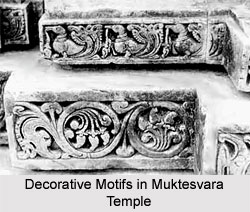 Decorative Motifs is one of the remarkable features of Muktesvara temple. The vegetal stems run in a circular path on the stone slabs and end in a small ball. Within the circles there are three sculpted buds. From each circle a new stem is shown to develop and then it runs in a similar fashion. The entire image is intricately done. The flower buds have been placed on the top and bottom. At the end the motif there is outgrown crook-shaped foliage. This decorative motif can be seen at the lowest plinth of the base.
Decorative Motifs is one of the remarkable features of Muktesvara temple. The vegetal stems run in a circular path on the stone slabs and end in a small ball. Within the circles there are three sculpted buds. From each circle a new stem is shown to develop and then it runs in a similar fashion. The entire image is intricately done. The flower buds have been placed on the top and bottom. At the end the motif there is outgrown crook-shaped foliage. This decorative motif can be seen at the lowest plinth of the base.
Another recurring motif is the jewellery design. This kind of sculpture is widely found on the ridges of the kumuda, a bevel shaped band. This has been done elaborately on the doorjambs. There is the image of the `hansa`, an aquatic white coloured bird that feeds on lotus stalks. The "hansa" is depicted as a bird that is walking with a flower bud in its beak. The friezes run around the base of the temple.
The makara motif is found on the pillar superstructure and the arches. Makara is the crocodile and it is used in the temple sculpture to represent the god of love, Kama. On the doorjambs one will once again come across the foliage sculpture. An open flower with four petals has been sculpted on the rhombus border. The `padma` flower or lotus is also a frequent decorative motif in the sculpture of Muktesvara temple.
In a vertical chain of circles, a vegetal stem draws its loop up to a small ball. From this another stem, drawing a new circle of same size, and so on. There are several motifs inside these circles: an open flower with twelve petals; three flower buds between crooks; alternately in reverse position, vegetal motifs of crook-shaped outgrowths; a flying human figure in one case. At the bottom there is a set of stems in concentric half circles from the centre of which the stem of the first circle issues. At the top there of vegetal crook-shaped outgrowths can be seen. This is found on the walls in free spaces between slender pilasters on each side of an axial niche.
Another beautiful image is at the top of the arch-ornamentation sculptured above the architectural pillar-superstructure motif. A rich foliage motif comes from the mouth and expands on both sides that form the upper part of the arch. There is an imaginary animal that is made of parts of different species, assembled together. The parts may be realistic.
The body looks like that of a dolphin.
The double curve moulding called padma is decorated with the design of a flower petal. The petal is itself ornamented with a design of vegetal crook-shaped outgrowths. The edge of the wall is chamfered. From petal to petal the vegetal decor varies.



















